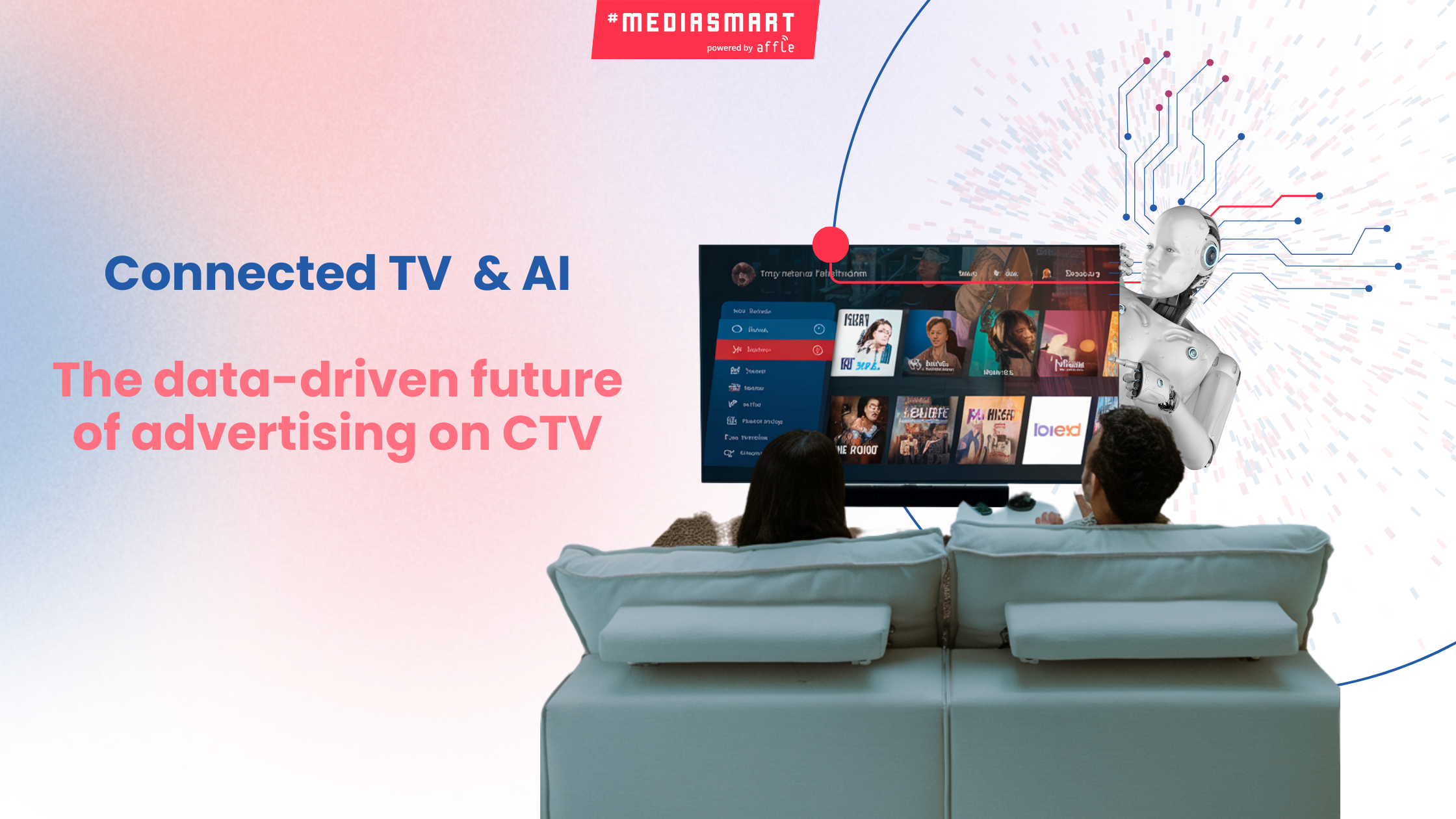Blog
Announcements, analysis and opinions on industry trends around the mobile programmatic world.

Subscribe now, and receive the latest programmatic content directly on your inbox!
Thank you for subscribing to our newsletter
Artificial Intelligence (AI) has revolutionized TV advertising. Once characterized by broad targeting and the hope of impacting the right audience, the traditional TV approach has been transformed into highly targeted, efficient Connected TV (CTV).
By leveraging data-driven insights, advertisers can optimize in real-time their budget allocations. Not only the application of machine learning, and automation mark this new era, ongoing innovation in AI and GenAI will be pivotal in shaping the future of CTV. Let’s explore it together.

From mass marketing to precise household targeting and measurable impact
Remember when TV ads reached everyone, whether they were interested or not? AI, machine learning (ML), and programmatic advertising have changed that. These technologies analyze viewing context, device usage, and location data to target specific households, not just broad inferred segments. Advertisers no longer rely on traditional TV panels; they can leverage insights to serve personalized ads to the most relevant audiences, increasing engagement and conversions.
Right on time. Personalization is no longer just a nice-to-have in advertising, it’s a critical driver of ROI. A study by Deloitte found that well-executed personalization can deliver 8x ROI on marketing spend and lift sales by 10% or more. By leveraging AI-powered segmentation, brands can tailor their creatives to different audience clusters, ensuring that each ad resonates with the right consumer at the right time. This level of data-driven precision reduces wasted ad spend, increases customer retention, and ultimately drives higher revenue for advertisers. This explains how 70% of organizations investing in AI prioritize data management.
Real-time optimization for maximum ROI
According to eMarketer, almost 90% of CTV ad spending is already programmatic, showing how dominant AI-driven ad placement buying has become. This shift has significantly improved campaign relevance and performance. Running a CTV campaign is like driving a high-performance car. AI is the autopilot adjusting everything in real time. It fine-tunes bids, picks the best ad slots, and even tweaks creative elements based on what works best.
AI doesn’t just guess, it learns and adapts. It optimizes CTV ad placement by using predictive analytics to forecast campaign performance and dynamically reallocate budgets to maximize impact. If a specific time slot, audience segment, or content type drives higher engagement, AI automatically shifts spend to capitalize on those opportunities. Real-time bidding optimization fine-tunes bids based on historical performance, competitor activity, and contextual signals, ensuring advertisers secure premium inventory at the best possible cost. Incrementality modeling further refines efficiency by isolating the true impact of ads, distinguishing between conversions driven by advertising and those that would have happened organically.
This level of automation reduces manual effort while increasing campaign effectiveness. By continuously learning from real-time data, AI makes every ad impression count. Automated decision-making ensures that advertisers get the most out of their budgets.
Fraud prevention & brand safety
The rise of CTV also brought a surge in ad fraud. Think bots faking views or spoofed inventory tricking advertisers. AI-powered fraud detection systems spot suspicious activity in milliseconds, ensuring brands pay for real views, not fake ones. Advanced machine learning models analyze patterns in ad traffic to detect anomalies, flagging fraudulent impressions before they impact campaign results. AI-driven verification ensures ads are placed in brand-safe environments, protecting advertisers from wasted budgets and reputation risks.
mediasmart’s AI-driven CTVSafe solution is an example of using AI to validate inventory and maintain brand safety. Continuous scanning and analyzing traffic ensures that advertisers only pay for genuine, viewable impressions. As CTV continues to grow, AI will remain critical in combating fraud, improving transparency, and maintaining the integrity of digital advertising.
GenAI and the Creative Revolution
Generating the perfect ad used to be a lengthy process. Enter generative AI (GenAI): the game-changer in ad creation. Now, AI can create scripts, voiceovers, and even video variations, making creative production faster and more scalable. While quality is still in question, the early stages of this technology promise excellent outcomes. With AI-generated content, brands can test multiple variations quickly and adapt creatives based on audience response. This means fewer production costs, quicker turnaround times, and more engaging ads tailored to viewers' preferences.
GenAI also powers A/B testing and dynamic creative optimization (DCO), ensuring that viewers see the most engaging version of an ad based on real-time data. Instead of a one-size-fits-all approach, we can dynamically assemble ad elements (visuals, messaging, and calls to action) based on what resonates best with different audience segments. According to a study by McKinsey, marketing functions could unlock 5–15% in productivity gains from their total spend by leveraging AI to generate creative assets, segment customers, and deliver personalized content at scale across languages, demographics, and geographies. The ability to instantly tweak and test creatives is a game-changer for advertisers looking to drive higher engagement and conversions.
Synchronization across screens
While it might seem like something out of the Minority Report movie, cross-screen synchronization is a 2025 reality. Consumers don’t just watch on one device anymore; they jump between TVs, smartphones, and tablets, and the most advanced programmatic platforms have adapted to that consumer behavior.
Through Machine Learning and real-time data management, we ensure ads are synchronized across these screens. Imagine seeing an ad for sneakers on your CTV and then receiving a 20% discount follow-up offer on your phone. AI can track user interactions and use data-driven insights to serve the next logical touchpoint in the conversion funnel. This kind of cross-device orchestration increases conversion rates and improves user experience. By leveraging AI for synchronized ad experiences, brands can create a unified marketing journey, that is more cohesive and effective in campaigns that drive higher ROI.
Innovation through AI
AI is not just refining what’s already possible. It’s enabling entirely new ways to advertise. Features like shoppable ads, interactive experiences, and real-time contextual targeting are all powered by AI. These innovations enhance the user’s experience, making ads feel less intrusive and more relevant. AI can analyze content in real-time, ensuring that an ad aligns with the context of the program or video being watched, increasing its effectiveness.
mediasmart’s smartAI content targeting solution is a perfect example of this innovation, ensuring that advertisers can precisely target publishers, such as OTTs, or gaming apps. By combining this AI-powered publisher analysis with real-time bid stream insights, brands can reach the right people at the right time while ensuring a brand-safe environment. Advertisers can expect even more groundbreaking features that redefine how CTV campaigns are executed as AI advances.
Acknowledging the challenges
Despite the advantages, AI-driven CTV ad buying also comes with challenges.
Transparency remains a key concern, as many AI models function as black boxes, making it difficult for advertisers to understand how budgets are allocated and why optimizations occur. Without clear visibility, it can be challenging to justify spending shifts or troubleshoot performance fluctuations.
Adding to the complexity, market volatility requires AI to adapt quickly to changes in consumer behavior, seasonality, and economic conditions. While AI excels at pattern recognition and real-time adjustments, unpredictable shifts, such as a major news event or sudden demand spikes can disrupt its predictive accuracy, leading to inefficiencies. Coupled with the management of data across devices and platforms, Privacy concerns arise.
According to the IAB Data Report 2024, 95% of marketers expect more legislation and signal loss, while 66% expect reduced personalization capabilities in states with privacy laws. As privacy regulations tighten restrictions on personal data usage, CTV advertisers will face growing difficulty in achieving accurate measurements. While AI thrives on data, its ability to deliver precise attribution is challenged by limited access to user-level signals and the decline of third-party identifiers. Consent-based marketing is here to stay. This shift forces reliance on probabilistic models and privacy-compliant identity frameworks. Advanced technology partners, such as mediasmart, can help advertisers leverage AI to capitalize on CTV’s potential.
Smart wrap-up
AI-powered CTV is not just the future; it's already here. Machine learning and data analysis are the engine making it all possible. AI is turning CTV into the most advanced and efficient advertising channel, benefiting from hyper-targeted ads to fraud protection, and dynamic creative to synchronized campaigns. By leveraging AI’s capabilities, advertisers can maximize reach, optimize performance, and create personalized experiences that resonate with viewers.
Brands that embrace AI-driven CTV strategies won’t just keep up, they’ll lead the pack. As AI technology evolves, its impact on CTV advertising will only grow stronger, offering advertisers new ways to engage audiences, drive conversions, and improve ROI. The future of CTV advertising is automated, and data-driven, powered by Artificial Intelligence.
Ready to start? Let’s talk.
Sources
1. Advancing the AI conversation | Deloitte Insights
2. Omnia AI - Hyper-Personalization in Marketing | Deloitte
3. Ad fraud on CTV, how it works, and what you need to know | Adjust
4. Steering CTV Programmatic Toward Trust And Transparency | AdExchanger
5. CTV Apps with the Highest Invalid Traffic | Pixalate
6. The economic potential of generative AI: The next productivity frontier | McKinsey
7. Data Report 2024 | IAB
8. CTV filling gaps declining linear TV ad spend | eMarketer
Topics: CTV, AI, ctv advertising, ctv ads, ctv measurement, AI-powered targeting, AI in programmatic, Generative AI, GenAI, Connected TV advertising, CTV vs traditional TV, CTV ad targeting, Programmatic TV advertising, CTV audience targeting, Future of TV advertising, CTV marketing strategy


